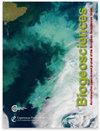Serpulid microbialitic bioherms from the upper Sarmatian (Middle Miocene) of the central Paratethys Sea (NW Hungary) – witnesses of a microbial sea
IF 3.9
2区 地球科学
Q1 ECOLOGY
引用次数: 0
Abstract
Abstract. We present previously unknown stacked bowl-shaped bioherms reaching a size of 45 cm in diameter and 40 cm in height from weakly solidified peloidal sand from the upper Sarmatian of the Paratethys Sea. The bioherms were mostly embedded in sediment, and the “growth stages” reflect a reaction on sediment accretion and sinking into the soft sediment. The bioherms are spirorbid–microclot–acicular cement boundstones with densely packed Janua tubes surrounded by microclots and acicular cement solidifying the bioherm. The surrounding sediment is a thrombolite made of peloids and polylobate particles (mesoclots) which are solidified synsedimentarily by micrite cement and dog-tooth cement in a later stage. The shape of the bioherms reflects a series of growth stages with an initial stage (“start-up stage”) followed by a more massive “keep-up stage” which grades into a structure with a collar-like outer rim and a central protrusion and finally by a termination of growth (“give-up stage”). The setting was a shallow subtidal environment with normal marine or elevated saline, probably oligotrophic, conditions with an elevated alkalinity. The stacked bowl-shaped microbialites are a unique feature that has so far been undescribed. Modern and Neogene microbialite occurrences are not direct analogues to the described structures, but the marine examples, like in The Bahamas, Shark Bay and the Persian Gulf, offer insight into their microbial composition and environmental parameters. The microbialites and the surrounding sediment document a predominance of microbial activity in the shallow marine environments of the Paratethys Sea during the late Middle Miocene, which was characterized by a warm, arid climate.帕拉特提斯海中部(匈牙利西北部)上萨尔马特世(中新世)的蛇形微生物生物圈--微生物海的见证者
摘要。我们在帕拉提提斯海上部萨尔马提亚弱固化的浅层沙中发现了以前未知的碗状生物礁,直径为45厘米,高度为40厘米。生物礁多嵌埋在沉积物中,“生长阶段”反映了沉积物的增生和向软质沉积物下沉的反应。生物囊是螺球-微凝块-针状水泥结合石,致密的Janua管被微凝块和针状水泥包围,使生物囊凝固。周围沉积物为似球粒和多片状颗粒(中凝块)组成的血栓,后期由泥晶胶结物和狗牙胶结物共同固化。生物泡的形状反映了一系列的生长阶段,包括初始阶段(“启动阶段”),然后是一个更大的“保持阶段”,这个阶段逐渐形成一个具有项圈状外缘和中心突出的结构,最后是生长的终止阶段(“放弃阶段”)。环境是一个浅层潮下环境,正常的海水或高盐水,可能是少营养的,碱性升高的条件。堆积的碗状微生物岩是迄今为止尚未描述的独特特征。现代和新近纪微生物岩的出现与所描述的结构没有直接的相似之处,但海洋中的例子,如巴哈马群岛、鲨鱼湾和波斯湾,提供了对其微生物组成和环境参数的深入了解。微生物岩及其周围沉积物表明,在中中新世晚期,旁提提斯海浅海环境中微生物活动占优势,气候温暖、干旱。
本文章由计算机程序翻译,如有差异,请以英文原文为准。
求助全文
约1分钟内获得全文
求助全文
来源期刊

Biogeosciences
环境科学-地球科学综合
CiteScore
8.60
自引率
8.20%
发文量
258
审稿时长
4.2 months
期刊介绍:
Biogeosciences (BG) is an international scientific journal dedicated to the publication and discussion of research articles, short communications and review papers on all aspects of the interactions between the biological, chemical and physical processes in terrestrial or extraterrestrial life with the geosphere, hydrosphere and atmosphere. The objective of the journal is to cut across the boundaries of established sciences and achieve an interdisciplinary view of these interactions. Experimental, conceptual and modelling approaches are welcome.
 求助内容:
求助内容: 应助结果提醒方式:
应助结果提醒方式:


